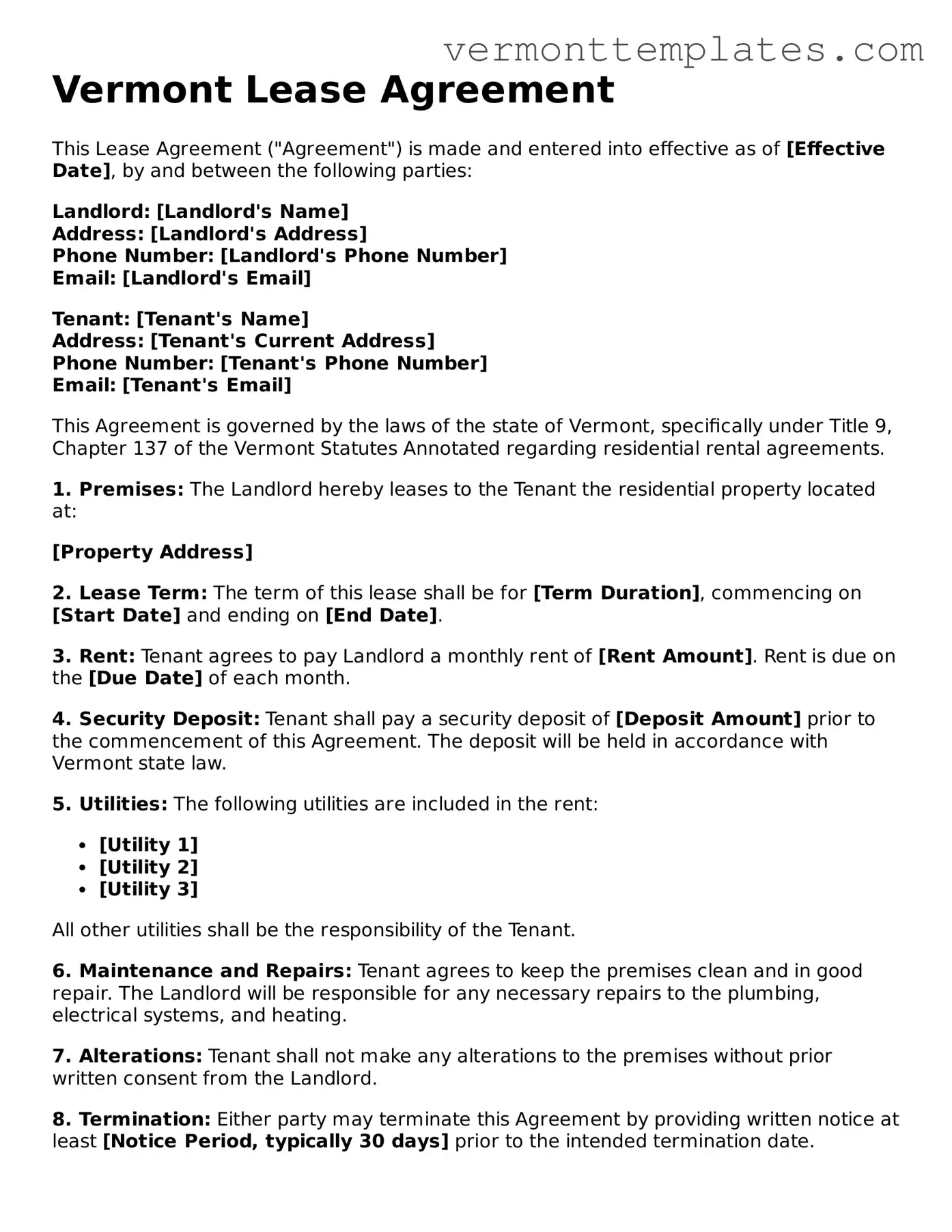The Vermont Lease Agreement is similar to the standard Residential Lease Agreement commonly used across the United States. Both documents outline the terms and conditions under which a tenant may occupy a rental property. They typically include details such as the duration of the lease, rental amount, security deposit requirements, and the responsibilities of both the landlord and tenant. The primary purpose of these agreements is to protect the rights of both parties while ensuring a clear understanding of the rental arrangement.
Another document that shares similarities with the Vermont Lease Agreement is the Commercial Lease Agreement. This type of lease is used for renting commercial spaces, such as offices or retail locations. Like the Vermont Lease Agreement, it specifies the terms of occupancy, payment schedules, and maintenance responsibilities. However, it often includes additional clauses specific to business operations, such as permissible use of the space and modifications to the property.
The Month-to-Month Rental Agreement is also akin to the Vermont Lease Agreement but offers more flexibility. This type of agreement allows tenants to rent a property on a monthly basis without a long-term commitment. Similar to the Vermont Lease Agreement, it outlines rental terms, but it can be terminated with relatively short notice. This document is particularly useful for tenants who may need to relocate frequently or for landlords who prefer not to enter into long-term leases.
A Sublease Agreement is another document that parallels the Vermont Lease Agreement. This agreement allows a tenant to rent out a portion or the entirety of their leased property to another individual, known as the subtenant. While the original lease terms remain intact, the sublease agreement must comply with the conditions set forth in the Vermont Lease Agreement, ensuring that both parties understand their rights and responsibilities.
The Roommate Agreement is similar in that it addresses the living arrangements among multiple tenants sharing a rental property. This document outlines the rights and responsibilities of each roommate, including payment of rent and utilities, house rules, and procedures for resolving disputes. While it does not replace the Vermont Lease Agreement, it complements it by providing clarity among individuals living together.
A Lease Purchase Agreement also bears resemblance to the Vermont Lease Agreement. This document allows a tenant to lease a property with the option to purchase it at a later date. It combines elements of leasing and purchasing, detailing the rental terms while also specifying the purchase price and conditions under which the tenant can buy the property. This agreement is beneficial for tenants who wish to eventually own the home they are renting.
When engaging in vehicle sales, understanding the necessary documentation is crucial, as highlighted by the requirements for the smarttemplates.net/fillable-california-motor-vehicle-bill-of-sale, which ensures that both the seller and buyer are protected throughout the transaction process in California.
The Rent-to-Own Agreement is another variant that shares characteristics with the Vermont Lease Agreement. This type of agreement allows tenants to rent a property with the intention of purchasing it after a specified period. Similar to the Lease Purchase Agreement, it outlines rental terms while incorporating conditions for eventual ownership. This arrangement can be appealing for tenants who may not currently qualify for a mortgage.
The Lease Extension Agreement is closely related to the Vermont Lease Agreement as it allows tenants to extend their lease term under the same conditions. This document is essential when both parties agree to continue the rental arrangement beyond the original lease period. It ensures that the terms remain consistent while providing clarity and continuity for both landlord and tenant.
The Rental Application is another important document that relates to the Vermont Lease Agreement. While it does not govern the terms of occupancy, it serves as a preliminary step in the leasing process. This document collects essential information about potential tenants, including their credit history and rental history, which helps landlords make informed decisions about whom to lease their property.
Lastly, the Eviction Notice is a document that, while not similar in purpose, is relevant in the context of lease agreements. If a tenant violates the terms of the Vermont Lease Agreement, the landlord may issue an eviction notice. This document formally communicates the landlord's intent to terminate the lease due to specific infractions, providing the tenant with information about their rights and the next steps in the eviction process.
